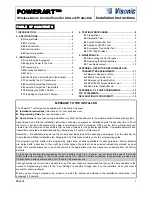
DE5458
7
3.8 PowerArt™-Compatible Detectors
Each detector compatible with the PowerArt™ system is
packed with its own installation instructions. Read them
carefully and install as indicated.
A. SPD-1000
SPD-1000 (Fig. 14) is a
wireless detector, used for
protection of paintings,
sculptures and other artwork,
in museums, galleries, private
artwork collections, etc.
Figure 14.
SPD-1000
B. PIR Motion Detectors
The wireless passive infrared (PIR) motion detectors used
in the system are of the PowerCode type. The PowerArt™
is capable of “learning” each detector’s identification code
and linking it to a specific zone (see Section 3 in the
Programming Manual). Some units are shown below:
Figure 15.
MC/PIR-2000
Figure 16.
MC/PIR-3000
or K-940MCW
Figure 17.
K-980MCW
Note:
K-940 MCW and K-980MCW are pet immune units.
In addition to its unique 24-bit identification code, each
detector transmits a message, containing status information:
•
The detector is in alarm (or not).
•
The detector is being tampered with (or not).
•
The battery voltage is low (or normal).
•
“This is a supervisory message”.
If any of these detectors detects motion, it sends out a
message to the alarm control panel. If the system is in the
armed state, an alarm will be triggered.
C. Magnetic Contact Transmitter
MCT-302 (Figure 18) is a PowerCode
magnetic-contact transmitter used to
detect the opening of a door or a window.
The alarm contacts are closed as
long as
the door or window remain
closed.
Figure 18.
MCT-302
The unit has an extra alarm input that acts as if it were a
separate wireless transmitter. It sends (or does not send)
a “restored to normal“ message to the alarm system,
depending on the setting of an on-board “DIP” switch. The
“restore” message informs you, through the control panel’s
display, whether the door or window is open or closed.
D. Wireless Adapter for Wired Detectors
MCT-100 (Fig. 19) is a PowerCode device
used mainly as a wireless adapter for 2
regular magnetic switches installed on 2
windows in the same room. The unit has
two inputs, behaving as separate wireless
transmitters and transmitting different
PowerCode IDs. Each input sends (or
does not send) a “restored“ message to
the alarm system, depending on the
setting of an on-board “DIP” switch.
Figure 19.
MCT-100
E. Wireless Smoke Detector
MCT-423
(unapproved by UL)
.
A photoelectric smoke detector
equipped with a PowerCode-type
transmitter. If enrolled to a fire
zone, it initiates a fire alarm upon
detection of smoke.
Figure 20.
MCT-423
F. Wireless Glass Break Detector
MCT-501
(Fig. 21). An acoustic detector
equipped with a PowerCode-type trans-
mitter. Since it restores automatically after
detection, this unit does not send a restoral
message to the alarm control panel.
Figure 21.
MCT-501
3.9 PowerArt-Compatible Transmitters
Note:
Each transmitter is packed with its own instructions
for battery installation and use. Be sure to pass these
documents on to the “Master User“ of the alarm system.
The PowerArt™ system is compatible with multi-button
and single button key-ring and hand-held transmitters that
use PowerCode and CodeSecure coding methods.
Multi-button PowerCode transmitters transmit the same
code each time the same button is pressed. They can be
used for emergency signaling, or for activating the PGM
output or for controlling appliances via X-10 units.
They
can not be used for arming / disarming.
CodeSecure transmitters are of the rolling code type - they
transmit a new code each time the same button is
pressed. This provides a higher security level, especially
in arming / disarming applications, because the code can
not be copied (“grabbed”) by unauthorized people.
Following are the basic details of several compatible
transmitters. The possible applications for each push-
button are indicated in each drawing.
A. MCT-234
(Fig 22): ‘Keyfob’
transmitter - one unit is
supplied with the PowerArt.
You can program the AUX
(auxiliary) button to perform
various tasks, in accordance
with the user’s needs.
Figure 22.
MCT-234
B. MCT-231 / MCT-201
(Fig.
23): Single-button pendant
units. The MCT-231 (Code-
Secure) and the MCT-201
(PowerCode) can be enrolled
to perform functions as
shown. Both units look alike.
Figure 23
. MCT-231 / 201
C. MCT-134 / MCT-104
(Fig.
24):
4-button hand-held units.
MCT-134 (CodeSecure) can
replace the MCT-234 keyfob.
MCT-104 (PowerCode) can
perform emergency and non-
alarm functions. Both units
look alike.
Figure 24.
MCT-134
/
104
D. MCT-132 / MCT-102
(Fig.
25): 2-button units. MCT-132
(CodeSecure) Can perform
functions as shown.
MCT-102
(PowerCode) can perform
emergency and non-alarm
functions. Both units look
alike.
Figure 25.
MCT-132
/
102
E. MCT-131 / MCT-101
(Fig.
26): Single-button units. The
MCT-131 (CodeSecure) and
the MCT-101 (PowerCode)
can be enrolled to perform
functions as shown. Both
units look alike.
Figure 26.
MCT-131
/
101
Содержание POWERART
Страница 15: ...DE5458 15 ...
















